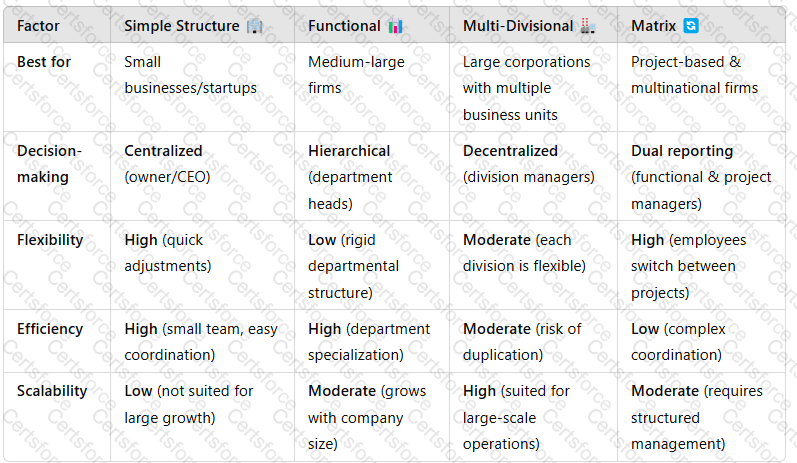Evaluation of Business Structures: Simple, Functional, Multi-Divisional, and Matrix
Introduction
A company’s business structure defines how itorganizes its people, processes, and decision-making hierarchy. The right structure helps an organizationoperate efficiently, communicate effectively, and achieve strategic goals.
This answer evaluates four common business structures:
Simple Structure– Small, centralized decision-making.
Functional Structure– Organized by business functions (e.g., marketing, finance).
Multi-Divisional Structure– Separate divisions with decentralized decision-making.
Matrix Structure– A hybrid of functional and project-based management.
Each structure hasadvantages and disadvantagesthat impactefficiency, flexibility, and strategic execution.
1. Simple Structure????(Small, Centralized Organization)
Explanation
Asimple structureis typically used bysmall businesses or startupswithfew employees and direct leadership by the owner or CEO.
✅Key Characteristics:
Centralized decision-making.
Minimal bureaucracy and hierarchy.
Quick adaptability to changes.
????Example:Alocal retail storeorfamily-owned restaurantwhere the owner makes all key decisions.
Advantages of a Simple Structure
✔Fast decision-making– No complex approval processes.✔Flexible and adaptable– Can quickly respond to market changes.✔Low operational costs– Minimal administrative expenses.
Disadvantages of a Simple Structure
❌Lack of scalability– Difficult to manage growth.❌Over-reliance on leadership– If the owner is absent, decision-making stalls.❌Limited specialization– Employees often perform multiple roles, reducing efficiency.
????Best for:Small businesses, early-stage startups, and family-run companies.
2. Functional Structure????(Organized by Department Functions)
Explanation
Afunctional structuregroups employees based onbusiness functions(e.g., HR, finance, marketing, operations).
✅Key Characteristics:
Specialization within departments.
Clear lines of authority.
Efficient division of work.
????Example:Amanufacturing companywith dedicated teams forproduction, sales, HR, and R&D.
Advantages of a Functional Structure
✔Encourages specialization– Employees develop expertise.✔Efficient resource allocation– Reduces duplication of roles.✔Clear chain of command– Reduces confusion in reporting lines.
Disadvantages of a Functional Structure
❌Silos between departments– Poor cross-functional communication.❌Slow decision-making– Requires coordination across departments.❌Limited flexibility– Harder to respond quickly to market shifts.
????Best for:Medium to large firms in stable industries (e.g.,banks, insurance companies, government agencies).
3. Multi-Divisional Structure (M-Form)????(Organized by Business Units or Divisions)
Explanation
Amulti-divisional structureconsists ofseparate business units (divisions), each operating independently under a corporate headquarters.
✅Key Characteristics:
Decentralized decision-making at the divisional level.
Each division focuses on a specific product, market, or region.
Corporate HQ oversees strategic direction.
????Example:Unileveroperates multiple divisions forfood, beauty, and household products, each with its own leadership team.
Advantages of a Multi-Divisional Structure
✔Faster decision-making– Divisions operate autonomously.✔Better market responsiveness– Each unit focuses on its unique customers.✔Risk diversification– If one division underperforms, others can offset losses.
Disadvantages of a Multi-Divisional Structure
❌Higher operational costs– Each division requires management and resources.❌Duplication of functions– HR, marketing, and finance teams may exist in multiple divisions.❌Potential competition between divisions– Internal rivalry may slow down collaboration.
????Best for:Large corporations withdiverse product lines or global operations(e.g.,Toyota, Amazon, PepsiCo).
4. Matrix Structure????(Dual Reporting: Functional & Project-Based Teams)
Explanation
Amatrix structurecombinesfunctional and project-based management, where employeesreport to both functional managers and project leaders.
✅Key Characteristics:
Employees work oncross-functional teamswhile still belonging to their department.
Encourages collaboration between different business functions.
Enhances project efficiency and resource sharing.
????Example:NASA and consulting firms (e.g., Deloitte, PwC)use matrix structures where engineers or consultants work onmultiple projectswhile reporting to department heads.
Advantages of a Matrix Structure
✔Encourages collaboration and knowledge sharing.✔Flexible and adaptable to projects.✔Better use of company resources– Employees work across different teams.
Disadvantages of a Matrix Structure
❌Complex reporting relationships– Employees may receive conflicting instructions.❌Higher administrative costs– Requires extensive coordination.❌Slower decision-making– More meetings and discussions needed to align multiple teams.
????Best for:Project-based companies, tech firms, multinational corporations(e.g.,Google, IBM, Boeing).
5. Comparison of Business Structures
 A screenshot of a computer
Description automatically generated
A screenshot of a computer
Description automatically generated
Key Takeaway:The choice of business structure depends oncompany size, industry, and strategic objectives.
Conclusion
Each business structure offersunique benefits and challenges:
✅Simple Structure– Best forsmall, agile businessesbut lacks scalability.✅Functional Structure– Encouragesefficiency and specializationbut createsdepartmental silos.✅Multi-Divisional Structure–Ideal for large firmswith diverse product lines butcan be costly.✅Matrix Structure– Encouragescollaboration and flexibilitybutis complex to manage.
Organizations must select abusiness structure that aligns with their strategic goals, operational needs, and industry requirements.
Submit